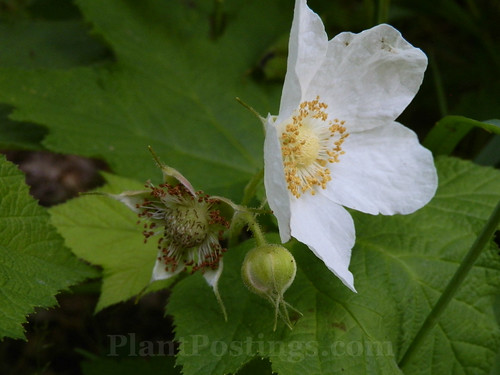
Are you familiar with this plant?
I have to admit I was not ... until discovering it recently along a trail at Newport State Park in Door County, Wis. The park is near the tip of the Door County peninsula that forms the "thumb" of Wisconsin's mitten shape.
The fishman and I did a lot of hiking last week. And one of the most plentiful plants along our Newport State Park trail was Thimbleberry (Rubus parviflorus). At first, we simply noticed it, took a few photos, and planned to look it up later for identification.
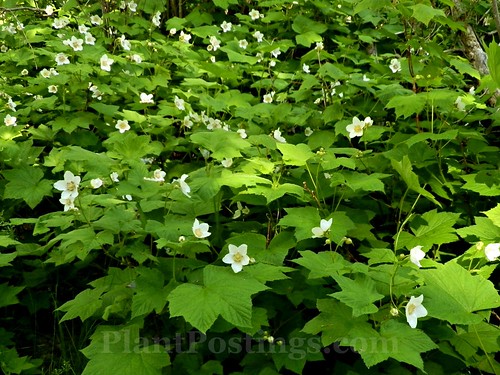
But as we continued our hike, the plant began to dominate the forest understory. I would have called it a forb, although later research revealed it's actually a shrub.
I also learned that Thimbleberry is rare, even in my state. It's found only in far northern Michigan and its Upper Peninsula, west through northern Wisconsin, and into the Pacific Northwest, according to the UW-Green Bay Herbarium. Thimbleberry needs cool summer temperatures to thrive.
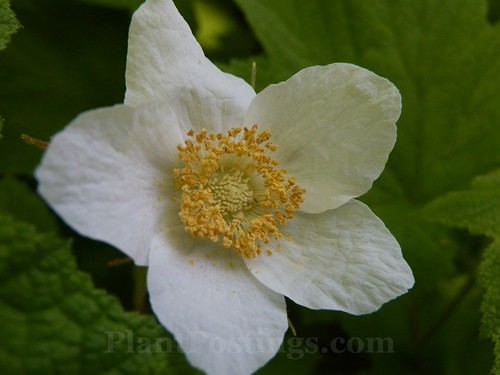
I guess I had heard of Thimbleberry before, but I don't remember seeing it. Most of the plants were in full bloom last week. The flowers are large, white, and showy, and the pollinators do a jig around the circular pollen pattern like they do with St. John's Wort and Mountain Mint.

The leaves look like Maples, about 4 inches long and wide. Thimbleberries ripen in late summer in Door County. The berries are larger and flatter than their cousins the Raspberries (Rubus spp. and hybrids), and they're fragile--making transport of fresh Thimbleberries nearly impossible, most sources agree. You can visit this UW-Green Bay link to see a photo of the berry.
But they taste great in Thimbleberry jam, which to me tastes very much like Raspberry or Strawberry jam. We bought some in Door County, although there are many online sources for buying Thimbleberry jam. I had a harder time finding a reliable online source for Thimbleberry wine, also recommended by some folks.
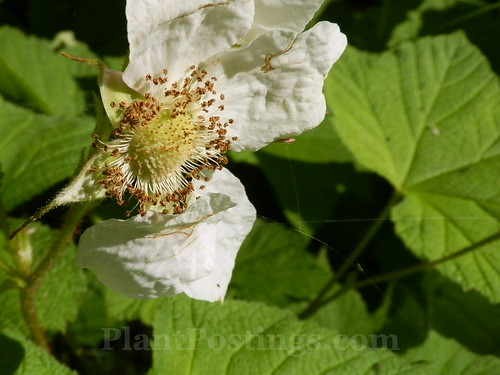
It's a beautiful plant, and it must be great fun to pick the plentiful berries later in the summer. You can see the fruit starting to form at the center as the petals drop.
I'm linking in with Gail's Wildflower Wednesday over at Clay and Limestone. Head on over to her blog to learn about wildflowers blooming around the world.
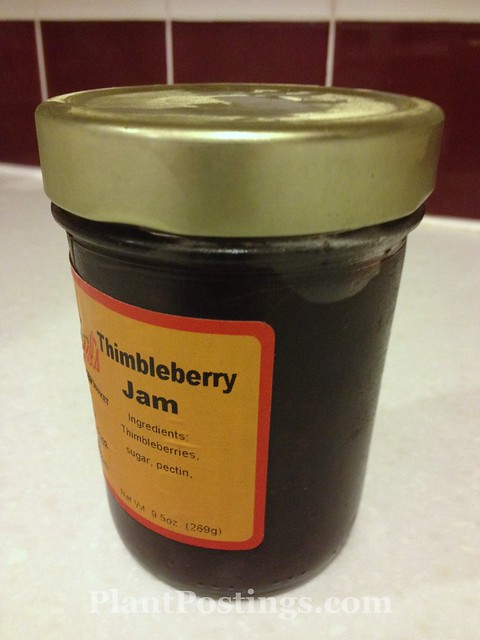
It's a new plant for me. I have never seen before. The flower looks so beautiful such as a single petal rose.
ReplyDeleteThank you for sharing
I agree, Endah--the flowers are beautiful. They really catch your eye (and pollinators' interest) when in full bloom!
DeleteA first for me too . . . love the delicate looking flower . . .
ReplyDeleteQuite exciting to see a few here and there, and then large patches of them along the trail!
DeleteHow beautiful it is in masses! And, the leaves are as pretty as the flowers.
ReplyDeleteBeth, thank you for pointing at the fruit starting to form! It's a little wonder!
The fruit forming is what clued me in that they were probably edible. I didn't find the plant in my wildflower guide, but was able to identify it based on the flower and the fruit. I agree--the entire process is a wonder and a gift!
DeleteI'd never heard of thimbleberry before, so thanks for the post. I would love to try some of that jam!
ReplyDeleteThe jam is good! Lots of sugar, but very tasty. Someday, I hope to try the berries. ;-)
DeleteWhat a beauty! I've never heard of it, either. I'd love to add it to my shade garden but it would croak in our heat.
ReplyDeleteI know, I'm sad too Tammy. My garden is definitely not "consistently cool" in July and August. Just one of those plants to appreciate from afar. I'd love to try the berries someday, though!
DeleteI've thought of planting this but have never pulled the trigger. You can buy it from Shooting Star Nursery in Kentucky and Oikos Nursery in Michigan.
ReplyDeleteAh, yes, I suppose your location near Lake Michigan might make its survival possible in your garden, Jason! Might be worth a try. My understanding is that it needs consistently cool temps throughout the summer. It would wilt and croak in my garden because Madison is too hot in July and August! ;-) Thanks for info on where to purchase the plants for those who want to try it!
DeleteThey grow along the roadside and volunteer in the garden around here. I don't think I would ever be able to collect enough of the berries to make jam though.
ReplyDeleteLucky you! I figured people in Washington and Oregon would be familiar with it. I think if my climate would allow it I might try to grow some. We have Black Raspberries up at our cottage, and some years are better than others. I'm guessing this year will be a bumper crop. It looked like the Door County Thimbleberries will be a bumper crop, too.
DeleteThis is a new-to-me plant as well. I've been to Door County, but don't remember seeing thimbleberry jam or wine. Thanks for visiting my "evening walk" -- did you also see the post on goat's-rue? It is blooming like crazy right now at the Arboretum's Grady Tract.
ReplyDeleteHi Heather: Sorry for the delay on my response. I got wrapped up with some projects and had a poor Internet connection over the weekend. I don't remember the Thimbleberry jam/wine from past visits, either. But maybe seeing the plant helped me to be more observant. ;-) I'll head back to your blog for the Goat's-Rue post. Thanks!
DeleteI have never heard of thimbleberries, but the flowers are certainly pretty, and I can imagine the jam would be delicious. The flowers look quite large. But are the berries very small? I guess flower size doesn't indicate berry size. I know so little aboiut berries! Thank you for the information about this interesting plant!
ReplyDeleteYes, the jam is great! I haven't seen the berries, but I get the impression they're similar in size to wild Raspberries but flatter and softer. I love berries of all types, so I'm pretty sure I'd like fresh Thimbleberries, too. ;-)
DeleteGrowing up on the West Coast, I am very familiar with Thimble berries...they usually bloomed just when the Salmon Berries did. They cover the forests of my childhood. Such a pretty little thing.
ReplyDeleteYes to April Fools...not sure it's my favorite day but still.
Jen
Hi Jen: Lucky you! The scene you describe is lovely: "They cover the forests of my childhood." Regarding April Fools' Day ... I'll have to remember that next year. ;-)
DeleteI have Thimbleberries growing wild in my yard, and I can fully understand why they were dominating the woods for your hike, they are very invasive and very hard to get rid of. The berries are very tasty, but not produced in a very big amount, so you need a lot of bushes to get much fruit.
ReplyDeleteNice! (At least in my limited exposure to them, it seems desirable.) I can't imagine wanting to get rid of them, but then I do have some native plants that behave in a similar way (Violets, Solomon's Seal, etc.). I'm thinking it would be pleasurable to gather the fruits in the woods where they're plentiful, but getting enough fruit to make jam and keeping it fresh before making it ... that could be a challenge.
DeleteWow, what an awesome plant! I've never heard of it before. That would be such a great plant to have - an understory plant that has such great berries!
ReplyDeleteYes, it would be nice. Unfortunately, Thimbleberries prefer a cooler summer climate--something I'm not crazy about. But they are beautiful plants!
DeleteInteresting plant, I have never come across it in the UK. although I have read that it is sometimes grown here. The one which seems more commonly grown is Rubus spectabilis, the salmonberry, but again not widely.
ReplyDeleteYes, I read something, too, about it growing in the U.K., too. Lots of the info covers both berries. I always enjoy learning more about plants--especially the ones that have edible parts!
DeleteBeth what a very interesting berry...I don't think I have heard of this but how lovely to see it and then taste it...wild berries are the best!
ReplyDeleteI agree, Donna! I love foraging for berries. Definitely a highlight of summer. Cheers!
DeleteI have not seen it here but it is common at the cottage of some friends we visit, north of Sault-Ste-Marie. It is a beautiful plant (the fruit I find rather insipid compared to raspberry). I have always been tempted to move some to the garden but I expect it likes acidic soil and we are very basic.
ReplyDeleteI remember that around Quebec city there was the pink version Rubus odoratus.
Ah, yes, I can imagine that it would thrive near Sault-Ste.-Marie. Lovely part of the world! It's been years since I've been there, but I have great memories of family time there. I have to say that my favorite is Black Cap Raspberries (R. occidentalis), mainly because they're plentiful here and they taste exquisite (and make a great jam or dessert)! Then again, most berries taste fabulous!
DeleteI think I have seen it but did not know its name. It really is pretty and would not have guesses it could be made into a jam.
ReplyDeleteI suppose I saw it, too, Donna, when I was a child living in northern Wisconsin. I didn't make the connection, though, and I doubt I've ever seen it in such high quantities that I saw it at Newport State Park.
DeleteThose thimbleberries are so lovely! And you can eat them too? Even better!
ReplyDeleteYes, the berries are edible, and apparently tasty! Well, I know the jam tastes good so the berries are probably yummy, too. I agree--a plant that's pretty and produces a tasty edible is tops for me!
DeleteI was completely unaware of this plant that is so beautiful and with edible fruit! Now I want to taste thimbleberry jam; maybe I can find some on the internet.
ReplyDeleteYes, there are lots of sources for jam, Deb. Many are small companies in the Pacific Northwest, the UP of Michigan, and northern Wisconsin. I hesitate to recommend one over the other. Good luck!
DeleteI think I may have seen it a few years ago in the UW Arboretum.
ReplyDeleteGood to know! I'll have to watch for it. I would have thought the Arb would be too warm, but of course it has lots of microclimates. Now you have me wondering if I should try growing Thimbleberries in my shady backyard! ;-)
DeleteBeth, you present so many plants I have never even heard of :-)
ReplyDeleteYet another new one for me, perhaps it doesn’t even grow in Britain or in Norway? I tried searching for it but didn’t get much beyond that it grows from Alaska to Mexico. Thanks for all the info, great stuff, and I love the common name for it!
Helene: Rick above mentions that it grows in the U.K., and I remember reading that, too. I would think it would love the climate in Norway, which is similar to northern Wisconsin. I'll have to do more research, too. It does look like a little thimble, doesn't it? :)
DeleteI've heard of Thimbleberry before but didn't know much about it, and I'm sure I've never seen it growing. The name itself is intriguing--makes me think of little fairies collecting the berries and making tiny jars of jam:)
ReplyDeleteTrying to catch up on back posts and found your kind comment here, Rose! I had similar thoughts about the name, too. Some say it's called Thimbleberry because the berry fits like a cap on your finger and is about the same size as a thimble. :)
Delete